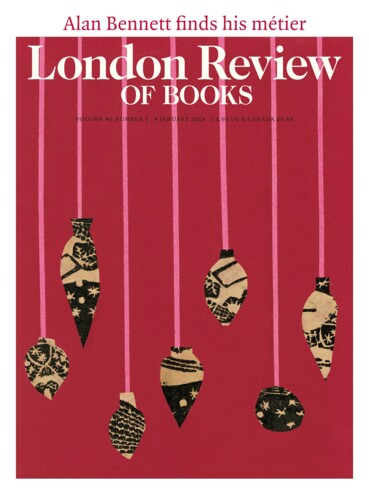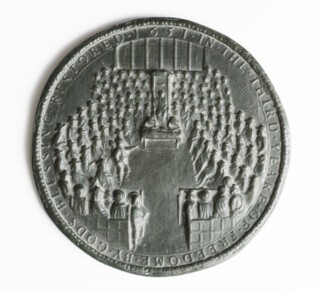The image on the seal is of the House of Commons in the mid-17th century, when the chamber was inside the old Palace of Westminster. It began to appear on seals, medallions and medals after Charles I had lost the war and Parliament was supreme. Once Charles was dead, moulds for his seals were smashed by a blacksmith in the Commons itself. The royal coinage was replaced by the Commonwealth’s: the transition was swift.
The frontispiece of Thomas Hobbes’s Leviathan depicts a one-headed sovereign whose body is made up of a multitude of people. The image on the seal represents the apotheosis of the House of Commons: no one is larger than anyone else, or the institution. A member of the House has risen from the front row benches to the left – he has the floor. This is Oliver Cromwell. The Speaker, then William Lenthall, sits on his high-backed chair while clerks of the House sit at the desk before him – as they do now. The ornamental mace lies on their table, its presence indicating that the House is in session. The Speaker’s chair is on the spot where the altar once stood – this had been St Stephen’s Chapel – and behind it is the east-facing window. You can just make out that the windows on the bottom level have been opened.
I have a copy of the seal. It may have lost some of its definition – it’s worn or has softened and if you hold it for more than a few seconds the black wax it’s made of becomes sticky – but the detail that remains is extensive: you can tell that the hundred-odd members represented are all wearing hats, except for Cromwell as he addresses the House.
The following inscription runs around the seal’s rim:
1651 in the Third Yeare of Freedome by Gods Blessing Restored.
On the reverse side, cut into the wax, are the words:
Republic d’Angleterre
1651
Seance du Parlement
There are also some indecipherable initials and numbers – I don’t know what to make of those. Nor do I know exactly when my copy was made, or who inscribed the French words.
Charles I was executed on 30 January 1648, old-calendar style, so that ‘Third Yeare’ – 1651 – identifies this as the second Great Seal of the Commonwealth, ordered by the Council of State and made by Thomas Simon. Simon had designed the first Commonwealth seal in a hurry, soon after Charles I’s execution and his own elevation: he had become chief engraver at the Mint. On the reverse of the finished 1651 seal is a map of England, Wales and Ireland. You can marvel at the intricate work: it ensured that the seal would be hard to counterfeit. Anyone who tried would be labelled a traitor and executed.
Thomas Simon seems to have worked together with his brother Abraham, though exactly how they operated isn’t clear. The National Gallery has a portrait of a heavily bearded Abraham; it also has an engraved version of Peter Lely’s portrait of him. (His beard made him a popular model; Van Dyck painted him as an apostle.) The 18th-century engraver George Vertue wrote a book about Thomas Simon; John Evelyn referred to him in Numismata, his discourse on medals, seals and coins. These objects, Evelyn wrote, ‘are the most lasting and vocal monuments of antiquity’. Proof, evidence and art are all involved, and in the 17th century proving who you said you were could require both a signature and a seal. On Charles I’s death warrant are the ‘hands and seals’ of those who wanted to end the monarchy.
The Simon brothers belonged to a family of five children; their parents, Pierre Simon and Ann Germain, were Huguenots, whose own families had escaped to Guernsey to avoid either the Inquisition in the Spanish Netherlands or persecution in France. The family attended what was known colloquially as the ‘French Church’ on Threadneedle Street, though the congregation wasn’t just French – Pepys went to hear sermons delivered there. Thomas became an apprentice at the Goldsmiths’ Guild; Abraham’s education is unknown. It seems that when they worked together Thomas executed the designs and casts while Abraham made the waxes.
Thomas Simon’s sketchbook is in the V&A. In it are his drawings of familiar Royalist, Commonwealth and Restoration figures, including one of Lenthall sitting on his high-backed chair as he does on the Great Seal, only he’s much larger here: his right arm is raised, and his right index finger is pointed like a cricket umpire’s – as if to indicate someone’s time is up. It’s a rough sketch, with few definite lines. There are also three heads of Charles I, with his famously watery eyes. There’s one of Henrietta Maria, as well as a picture of a young Charles II in armour. Thomas Wentworth, Earl of Strafford is drawn in ink.
Simon joined the Royal Mint as an engraver in the early 1640s. He was an avowed Parliamentarian, but he helped make seals and coinage for Charles I. After Cromwell defeated the Scots at the Battle of Dunbar in 1650, he commissioned a medal of himself, which he distributed to his officers – a practice known on both sides during the wars of the English Revolution. On the reverse of the medal is the same image of the House of Commons as the one on the Great Seal. Cromwell said of Simon that his ‘pains and trouble hither have been very great … The man is ingenious and worthy of encouragement.’ Simon also made a seal for Cromwell when he became lord protector; on it, Cromwell rides a horse over all of London. The inscription is in Latin, the language of monarchs and Catholics, which was supposed to have been replaced by English at the beginning of the Commonwealth, but must have seemed fitting for a ‘lord protector’.
The message of Cromwell’s seal is obvious: a single figure dominates the scene – the ‘arch usurper’, as Evelyn described him. It’s no surprise, really, that when Simon came to make the great seal of state for Charles II in 1660, he chose exactly the same image – the king riding his horse over the city – but he’s facing in the opposite direction to Cromwell. Charles II had the engravers at the Royal Mint at work on a new coinage three days after his arrival in London. But having heard that the king was considering turning to two Dutch engravers, Simon decided to show off. He sent Charles a crown; it’s only a fraction of a centimetre thick but Simon managed to inscribe the following minute words in two lines around its rim:
THOMAS SIMON MOST • HUMBLY- PRAYS-YOUR • MAJESTY • TO • COMPARE • THIS • HIS • TRYALL • PIECE • WITH • THE • DVTCH • AND • IF • MORE • TRVLY • DRAWNE & EMBOSS’d • MORE • GRACE FVLLY • ORDER’D • AND • MORE • ACCVRATELY • INGRAVEN • TO • RELEIVE • HIM.
I came across this copy of the Great Seal of the Commonwealth in the flat of a recently deceased relative. (Hanging on a nearby wall was a portrait of Charles I.) On 14 December, the day after MPs asserted their right to vote on the final terms of the UK’s withdrawal from the EU, the Times published a photo on its front page of the packed House of Commons, as if to make a point about the primacy of Parliament. Theresa May’s government was the loser that day. The scene is essentially the same as it is on the seal. Only the hats are missing.
Send Letters To:
The Editor
London Review of Books,
28 Little Russell Street
London, WC1A 2HN
letters@lrb.co.uk
Please include name, address, and a telephone number.


